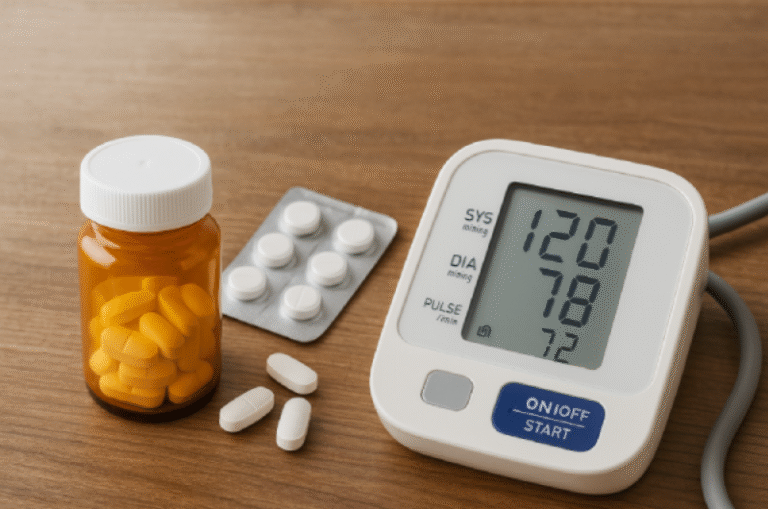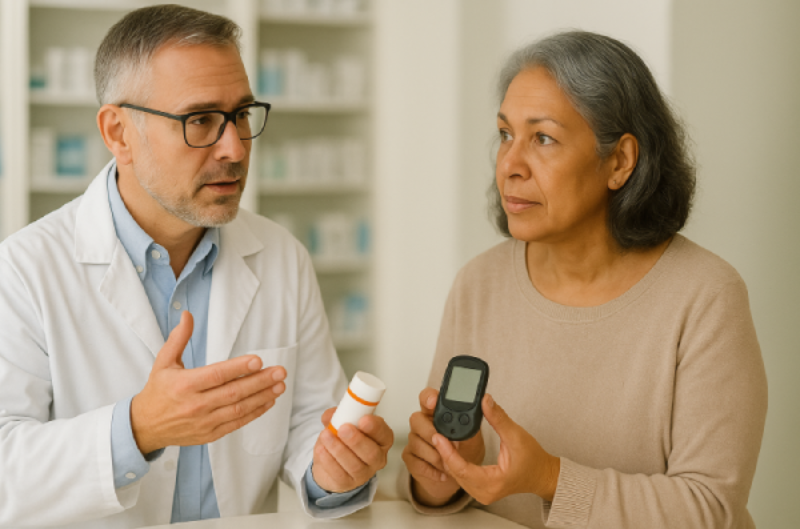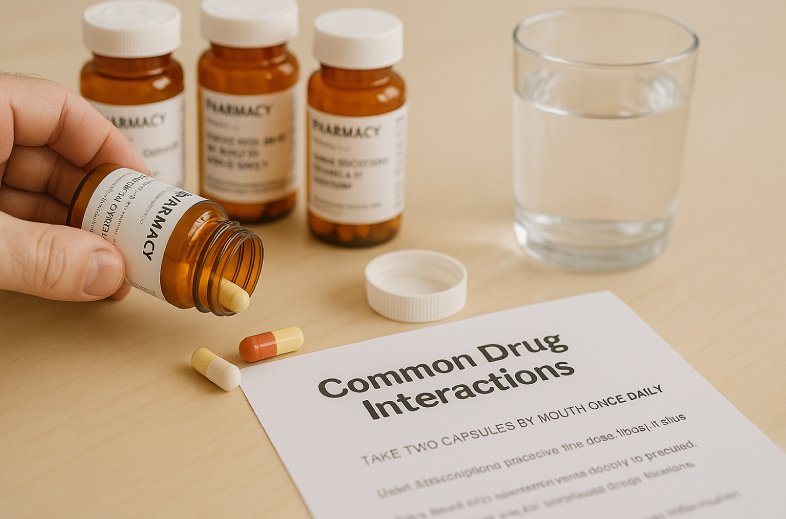Blog
Stay informed with the latest health tips, medication insights, and wellness advice from our expert PharmDs.

Understanding Your Blood Pressure Medications
High blood pressure is common, and so are the medications to treat it. Learn about the different types, how they work, and common side effects.
Understanding Your Blood Pressure Medications
Understanding Your Blood Pressure Medications: A Comprehensive Guide
High blood pressure, or hypertension, is often called the “silent killer” because it usually has no obvious symptoms. Yet, left unchecked, it significantly increases your risk of serious health issues like heart attack, stroke, and kidney disease. If your doctor has prescribed blood pressure medication, you’re not alone. Millions manage their blood pressure successfully with the right treatment plan.
But what do these medications do, and how do they work? Let’s break down the different types and how they contribute to your heart health, along with crucial lifestyle adjustments.
The Role of Medication: A Team Effort
Blood pressure medications work in various ways to help your body maintain a healthy blood pressure level. Your doctor will choose the best medication, or combination of medications, based on your individual health profile, other conditions you might have, and potential side effects.
Here are some of the most common categories:
- Diuretics (“Water Pills”): These medications help your kidneys remove excess sodium and water from your body, reducing the fluid volume in your blood and easing the burden on your heart.
- Examples: Hydrochlorothiazide, Furosemide.
- Common Side Effects: Increased urination, dizziness, muscle cramps.
- ACE Inhibitors (Angiotensin-Converting Enzyme Inhibitors): These drugs relax and widen your blood vessels by blocking the formation of a natural chemical that narrows them. This allows blood to flow more easily.
- Examples: Lisinopril, Enalapril, Ramipril.
- Common Side Effects: Dry, persistent cough, dizziness.
- ARBs (Angiotensin II Receptor Blockers): Similar to ACE inhibitors, ARBs relax blood vessels, but they do so by blocking the action of the chemical that constricts them. They are often prescribed if ACE inhibitors cause a cough.
- Examples: Losartan, Valsartan.
- Common Side Effects: Dizziness, high potassium levels.
- Beta-Blockers: These medications slow your heart rate and reduce the force of your heart’s pumping action. This makes it easier for your heart to pump blood, lowering blood pressure.
- Examples: Metoprolol, Atenolol.
- Common Side Effects: Fatigue, slow heart rate, cold hands or feet.
- Calcium Channel Blockers (CCBs): CCBs prevent calcium from entering the cells of your heart and blood vessel walls. This relaxes and widens blood vessels, and some also slow your heart rate.
- Examples: Amlodipine, Diltiazem.
- Common Side Effects: Ankle swelling, headache, constipation.
Other less common but important classes include Alpha-Blockers, Central-Acting Agents, Direct Renin Inhibitors, and Vasodilators, each working through distinct mechanisms to achieve blood pressure control.
Why Adherence Matters: Stick to Your Plan!
Taking your blood pressure medication exactly as prescribed is paramount. Skipped doses can lead to uncontrolled blood pressure, significantly increasing your risk of heart attack, stroke, and kidney damage. If you’re struggling to remember doses or are experiencing side effects, never stop your medication without talking to your doctor first. There are often solutions, like adjusting the dosage, changing to a different medication, or finding strategies to help you remember.
Beyond the Pill: The Power of Lifestyle
While medication is vital, lifestyle changes are equally crucial and can even reduce your need for medication over time. These habits complement your treatment, making it more effective and boosting your overall well-being.
- Heart-Healthy Diet: Embrace the DASH (Dietary Approaches to Stop Hypertension) eating plan. Focus on fruits, vegetables, whole grains, and lean proteins. Significantly reduce your intake of sodium (salt), unhealthy fats, and processed foods.
- Regular Exercise: Aim for at least 30 minutes of moderate-intensity aerobic activity most days of the week, totaling about 150 minutes per week. This could be brisk walking, cycling, swimming, or dancing. Also, incorporate strength training a couple of times a week.
- Stress Management: Chronic stress can contribute to high blood pressure. Practice stress-reducing techniques like deep breathing exercises, meditation, yoga, or spending time on hobbies you enjoy. Ensuring you get 7-9 hours of quality sleep each night is also crucial.
When to Consult Your Healthcare Provider
Being aware of potential side effects and knowing when to seek help is important.
- Common & Manageable: Mild dizziness, a dry cough (with ACE inhibitors), or mild fatigue are often temporary and can be discussed at your next routine appointment.
- Call Your Doctor Soon: If you experience persistent dizziness, lightheadedness, shortness of breath, irregular heartbeats, or persistent fatigue, contact your doctor promptly. These might indicate a need for a medication adjustment.
- Emergency (Call 108): Seek immediate medical attention if you experience severe symptoms like swelling of the face, mouth, or throat (angioedema), yellowing of the skin/eyes, extreme confusion, or symptoms of a heart attack (chest pain) or stroke (sudden weakness on one side, slurred speech).
Partnering with Your Healthcare Team
Managing high blood pressure is a journey, not a destination. Your doctor is your most important partner. Regularly monitor your blood pressure at home and keep a record to share with your doctor. Don’t hesitate to ask questions about your medications, potential side effects, or how lifestyle changes can further support your health goals.
By understanding your medications and embracing healthy habits, you can take control of your blood pressure and pave the way for a healthier, more vibrant future.

The Pharmacist's Role in Managing Your Diabetes
Pharmacists play a vital role in diabetes care, from medication education to helping you monitor your blood sugar levels effectively.
The Pharmacist's Role in Managing Your Diabetes
Your Pharmacist: An Untapped Resource in Diabetes Management
For many, the friendly face behind the pharmacy counter is primarily associated with filling prescriptions. But what if I told you your pharmacist is a vital — and often underutilized — partner in managing a complex condition like diabetes?
Living with diabetes is a daily challenge, demanding constant attention to medication schedules, blood sugar monitoring, and lifestyle adjustments. It can feel overwhelming, but you don’t have to navigate it alone. Pharmacists are stepping up, evolving into accessible healthcare providers and medication experts uniquely positioned to offer comprehensive support in chronic disease management.
Here’s how your pharmacist can become your powerhouse in diabetes care:
The Medication Maestro: Beyond the Bottle
Your pharmacist does much more than count pills. They are medication experts who ensure your treatment is safe, effective, and personalized.
- Optimizing Your Regimen: Through services like Medication Therapy Management (MTM) and Comprehensive Medication Reviews (CMR), pharmacists analyze your entire medication list. This helps identify necessary adjustments, prevent issues like “prescribing cascades” (when one medication’s side effect is treated with another medication), and improve how consistently you take your meds. Studies show pharmacist-led MTM programs can significantly improve diabetes management.
- Navigating Complex Prescriptions: Ever feel confused about how to take a new diabetes medication, or why you’re taking it at all? Your pharmacist can break it down, explaining how different medications work together and even simplifying complex regimens, sometimes offering services like blister packing for easier organization. They act as a critical “second check” for prescriptions, enhancing safety.
- Managing Side Effects and Interactions: Starting a new medication can bring new questions about side effects. Your pharmacist can explain potential reactions, help you distinguish between common and serious ones, and offer practical tips to manage discomfort. They’re also vigilant about preventing dangerous drug-to-drug interactions.
- Enhancing Adherence: Sticking to your medication plan is crucial for diabetes management. Pharmacists offer personalized guidance and ongoing follow-up to address barriers like cost, confusion, or forgetfulness, providing continuous support vital for long-term success.
Empowering You: Education Beyond Expectations
Pharmacists don’t just dispense; they educate and empower. They give you the knowledge and practical skills you need for successful self-management.
- In-depth Diabetes Education: Pharmacists are trained in chronic disease management and can provide extensive guidance on maintaining optimal glucose levels and making lifestyle changes. They help you understand why your medications are necessary, empowering you to take an active role in your care.
- Hands-on Training for Self-Monitoring: Using your glucometer or Continuous Glucose Monitor (CGM) can feel daunting at first. Your pharmacist can provide hands-on training, covering everything from sensor application to interpreting metrics like Time in Range (TIR).
- Mastering Insulin Administration: If you use insulin or other injectable medications, your pharmacist can offer essential training to build your confidence, demonstrating correct techniques and addressing common concerns like needle phobia.
- Lifestyle Coaching: Beyond meds, pharmacists counsel on healthy eating (like the “Plate Method”), physical activity (aiming for 150 minutes weekly of moderate-to-vigorous activity), and mental well-being, reinforcing the holistic nature of diabetes care.
Proactive Health: Prevention and Protection
Your pharmacist also plays a crucial role in preventing complications and ensuring you receive vital protective measures.
- Diabetes Prevention Programs: Many pharmacists are involved in screening for prediabetes and can refer you to evidence-based lifestyle change programs, leveraging their accessibility to reach high-risk individuals.
- Recommended Vaccinations: People with diabetes are at higher risk for certain infections. Your pharmacist can ensure you’re up-to-date on recommended vaccinations (like flu and pneumonia), often administering them right in the pharmacy.
- Identifying Gaps in Care: Pharmacists are instrumental in spotting and addressing any gaps in your care by reviewing your health records. They can help remind you to schedule important preventive appointments, such as annual retinal exams, foot exams, and urine microalbumin testing.
The Power of Partnership: Collaborative Care
Effective diabetes management is a team sport, and your pharmacist is an essential teammate.
- Part of Your Healthcare Team: Organizations like the American Diabetes Association (ADA) recognize pharmacists as crucial members of the diabetes care team, working alongside physicians, nurses, and dietitians to provide integrated, patient-centered care.
- Collaborative Drug Therapy Management (CDTM): In many areas, qualified pharmacists can work directly with physicians under CDTM agreements to perform patient assessments, order lab tests, administer medications, and even adjust therapy regimens. This allows for timely medication adjustments, helping you reach your health goals faster.
- Improving Communication: Pharmacists enhance continuity of care, especially during transitions (e.g., hospital to home), preventing medication errors and reducing readmissions through better communication across healthcare providers.
- Leveraging Technology: From online refill services to telehealth consultations and interpreting real-time CGM data, pharmacists use technology to make your diabetes care more convenient and effective.
The Tangible Impact: Better Health, Lower Costs
The expanded role of pharmacists translates into measurable benefits for both you and the healthcare system.
- Improved Health Outcomes: Pharmacist interventions consistently lead to better clinical markers. On average, studies show significant reductions in HbA1c (blood sugar control, often by 1.4% to 1.78%), improvements in blood pressure (reductions in systolic and diastolic readings), and positive changes in BMI.
- Reduced Healthcare Costs: By helping you stay on track with medications, preventing complications, and identifying unnecessary prescriptions, pharmacists help reduce high-cost episodes of care and hospitalizations. Their involvement is an investment that lowers overall healthcare utilization over time.
- Enhanced Quality of Life: Beyond the numbers, pharmacist support leads to better medication adherence, greater engagement in self-care, and a deeper understanding of your condition. This all contributes to increased patient satisfaction and an improved health-related quality of life.
Take Charge of Your Diabetes with Your Pharmacist
Your pharmacist is a highly accessible, knowledgeable, and proactive healthcare professional ready to support your diabetes journey. Don’t hesitate to ask questions, seek their advice, and explore the wide range of services they offer.
By actively partnering with your pharmacist, you can gain a deeper understanding of your condition, enhance your self-management skills, and ultimately achieve better health outcomes and a higher quality of life. Make your pharmacist a central figure in your diabetes care team, and take charge of your health today!

Common Drug Interactions: What You Need to Know
Taking multiple medications, supplements, or even certain foods can sometimes lead to harmful interactions. Learn about common types and how
Common Drug Interactions: What You Need to Know
Common Drug Interactions: What You Need to Know
Medications are powerful tools for managing our health, but their safety and effectiveness can sometimes be influenced by other substances. A drug interaction happens when a substance—be it another medication (prescription or over-the-counter), a food, a beverage, or a dietary supplement—alters the way a drug acts in your body. This can change how effective or safe a drug is, sometimes leading to unexpected side effects or even making the drug harmful.
In today’s healthcare landscape, it’s common for individuals to take multiple medications. This complex mix significantly increases the potential for interactions, making awareness and proactive management crucial for everyone, particularly older adults and those with chronic health conditions.
Understanding Drug Interactions: The Basics
Drug interactions aren’t random; they occur through specific biological and chemical mechanisms. Broadly, these fall into two categories:
- Pharmacokinetic Interactions: These affect how your body handles a drug. This includes how it’s absorbed into your bloodstream (e.g., dairy products binding to certain antibiotics, preventing absorption), metabolized (broken down, often by liver enzymes), distributed throughout your body, and excreted (eliminated, mainly through kidneys). For instance, grapefruit juice can inhibit enzymes in your liver, leading to dangerously high levels of certain medications.
- Pharmacodynamic Interactions: These involve how the drug affects your body at its site of action. This might mean two drugs have similar effects and amplify each other (e.g., two sedatives causing extreme drowsiness) or opposing effects that cancel each other out.
Common Interactions to Be Aware Of
While it’s impossible to list every potential interaction, being aware of common, significant examples can empower you to make safer choices.
Drug-Drug Interactions
These occur when two or more medications react with each other.
- Warfarin (blood thinner) & NSAIDs (e.g., Aspirin, Ibuprofen): Greatly increases the risk of severe bleeding.
- Sedatives/Opioids & Antihistamines: Amplified drowsiness, impaired coordination, and dangerous respiratory depression.
- Fluconazole (antifungal) & Simvastatin (cholesterol medication): Fluconazole can increase simvastatin levels, raising the risk of muscle pain and severe side effects.
- Bactrim (antibiotic) & Warfarin: Can significantly enhance warfarin’s blood-thinning effect, leading to excessive bleeding.
Drug-Food/Beverage Interactions
These happen when a drug reacts with certain foods or drinks, affecting absorption or metabolism.
- Grapefruit/Grapefruit Juice & Statins (e.g., Lipitor), Calcium Channel Blockers: Can significantly increase drug levels in your blood, raising the risk of severe side effects.
- Warfarin & Vitamin K-rich Leafy Green Vegetables: If your intake of these foods is inconsistent, it can counteract warfarin’s blood-thinning effects.
- Antibiotics (e.g., Tetracyclines, Ciprofloxacin) & Dairy Products: Calcium in dairy can bind to these antibiotics, preventing their absorption and making them less effective. Take them 1-2 hours apart.
- MAOIs (a type of antidepressant) & Tyramine-rich foods (e.g., aged cheeses, cured meats, red wine): Can cause a dangerous spike in blood pressure.
Drug-Alcohol Interactions
Alcohol can significantly alter how many medications work and can increase side effects.
- Alcohol & Sedatives/Tranquilizers: Leads to extreme drowsiness, impaired coordination, and slowed breathing. This combination can be fatal.
- Alcohol & NSAIDs (e.g., Ibuprofen, Aspirin): Increases the risk of stomach irritation, ulcers, and internal bleeding.
- Alcohol & Acetaminophen (Tylenol): Chronic alcohol use combined with acetaminophen is a common cause of severe liver damage.
- Alcohol & Metformin (diabetes medication): Increases the risk of lactic acidosis, a serious and life-threatening condition.
- Alcohol & Certain Antibiotics (e.g., Metronidazole, Sulfamethoxazole/Trimethoprim): Can cause a disulfiram-like reaction with symptoms like nausea, vomiting, flushing, and rapid heartbeat.
Drug-Supplement/Herb Interactions
Natural doesn’t always mean safe. Many supplements and herbs can interact with medications.
- St. John’s Wort & Antidepressants, Birth Control, Blood Thinners: This herb can reduce the effectiveness of many medications and, with antidepressants, can lead to a dangerous condition called serotonin syndrome.
- Vitamin K (supplement) & Blood-Thinning Medications (e.g., Warfarin): Directly counteracts warfarin’s effects, increasing clotting risk.
- Iron/Calcium Supplements & Thyroid Hormone Replacement (Levothyroxine): These minerals can interfere with the absorption of thyroid medication. Take them at least four hours apart.
- Ginkgo Biloba, Garlic, Dong Quai & Blood Thinners/Antiplatelet Agents: These can increase the risk of bleeding when combined with blood-thinning medications.
Who’s at Higher Risk?
While anyone can experience a drug interaction, certain factors significantly increase susceptibility:
- Polypharmacy: Taking multiple medications (prescription, OTC, supplements) simultaneously. The more drugs you take, the higher the risk.
- Older Age: Individuals 65 and above are at higher risk due to physiological changes affecting drug processing and often having multiple chronic health conditions.
- Multiple Prescribers: Seeing different doctors who may not have a complete, up-to-date list of all your medications.
- Certain Health Conditions: Especially those affecting the liver or kidneys, which are crucial for drug metabolism and elimination.
Recognizing the Signs
Knowing the potential signs and symptoms of a drug interaction is crucial for timely recognition and intervention. Symptoms can vary widely, but often include:
- Nausea, vomiting, diarrhea, or severe stomach pain
- Drowsiness, dizziness, confusion, or unsteadiness
- Abnormal heartbeat or changes in blood pressure
- Unexpected bruising or prolonged bleeding
- Muscle pain or weakness
- New or worsening symptoms of your original condition
Seek immediate medical attention if you experience severe symptoms like excessive bleeding, dangerous changes in blood pressure, irregular heart rhythms, difficulty breathing, or seizures.
Your Action Plan: Preventing and Managing Drug Interactions
While drug interactions can be serious, many are preventable. Taking proactive steps and maintaining open communication with healthcare providers are your best defenses.
- Be Transparent with Your Healthcare Team: Always talk to your doctor or pharmacist before taking any new medication (prescription or OTC), dietary supplement, vitamin, or herbal product. Make sure to mention alcohol, tobacco, and any recreational drug use.
- Maintain a Comprehensive Medication List: Keep an updated, detailed list of everything you take. This list is an indispensable tool for doctors and pharmacists to identify potential interactions. Include the full name, active ingredients, reason for taking, exact dose, timing, any special instructions, and the prescribing doctor.
- Read Labels Carefully: Pay close attention to active ingredients and warnings on all over-the-counter drug labels.
- Adhere to Instructions: Follow the exact dose and timing instructions for all your medications. If you have questions about whether it’s safe to drink alcohol with a medication, always ask your pharmacist or doctor.
- Centralize Your Pharmacy: Use one pharmacy for all your prescriptions. This allows your pharmacist to keep a comprehensive record and identify potential interactions before they become a problem.
- Regular Medication Review: At least once a year, review all your medications (prescriptions, OTCs, supplements) with your doctor or pharmacist.
- Never Self-Adjust or Stop Medications: Always seek a physician’s guidance before stopping or changing the dose of any medication.
Conclusion: Empowering You to Stay Safe
Drug interactions are a serious but often preventable aspect of medication safety. By being informed, proactive, and maintaining open, honest communication with your healthcare providers, you become your most effective advocate in managing your health.
The health journey is a partnership. Armed with the knowledge of common drug interactions and a commitment to careful medication management, you can significantly reduce your risk of adverse events and ensure that your treatments are as safe and effective as possible.

